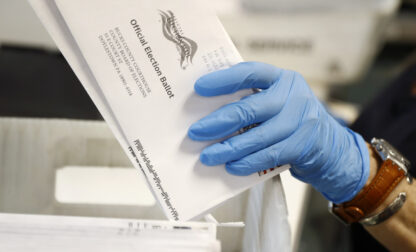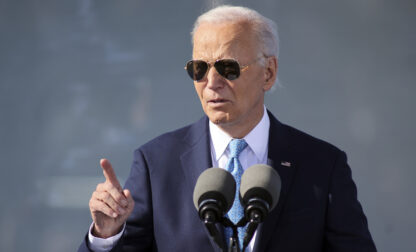
In the 2020 U.S. general election, AP declared winners in more than 5,000 contested races – starting with the White House and reaching down the ballot to every seat in every state legislature. This hallmark of AP’s election news report is produced by a dedicated team of election analysts, researchers and race callers who make up our Decision Team.
AP does not make projections or name apparent or likely winners. If our race callers cannot definitively say a candidate has won, we do not engage in speculation. AP did not call the closely contested race in 2000 between George W. Bush and Al Gore – we stood behind our assessment that the margin in Florida made it too close to say who won.
Only when AP is fully confident a race has been won – defined most simply as the moment the trailing candidates no longer have a path to victory – will we make a call.
Many races are won on election night, but it’s not uncommon for it to take a few days – and in rare instances, a few weeks – to reach that point.
In the 2020 presidential election, AP declared Joe Biden the winner four days after Election Day – at 11:26 a.m. ET on Saturday, Nov. 7.
AP’s Decision Team is driven entirely by the facts. Race calls made by other organizations have no bearing on when AP declares a candidate the winner. Our team does not engage in debate with any campaign or candidate. Should a candidate declare victory – or offer a concession – before AP calls a race, we will cover newsworthy developments in our reporting. In doing so, we will make clear that AP has not yet declared a winner and explain the reason why we believe the race is too early or too close to call.
When AP makes a race call, we back it up with transparent reporting into the research and analysis that led us to say with certainty who has won. This explanatory journalism is as much a hallmark of our coverage of U.S. elections as the race calls themselves.
Frequently asked questions
AP’s race callers are employees who are deeply familiar with the states where they declare winners. Most have called declared winners in a state for many years. Their work begins months before the day of an election, as they study election rules and recount requirements and track changes and updates to election law. They work with AP’s political and government reporters to sharpen their understanding of campaigns and track coverage of races from AP member news organizations and customers.
They also review and rely on information from AP’s elections research group. They know before polls close how each county and congressional district in their state has voted in past elections, the state’s past results for voting by mail and early in-person voting, and the state’s history of counting votes – how many are counted after polls close and how many are counted in the days after.
Every election year, race callers also complete extensive training sessions designed to review and refresh the analytical skills required to make accurate decisions on election night.
AP’s Decision Team has a wide range of tools at its disposal to analyze the state of a race. They include AP’s vote count, which it has conducted in every U.S. presidential election since 1848. In general elections and presidential primaries, the Decision Team also has access to data from AP VoteCast, our wide-ranging survey of the American electorate.
Race callers collaborate with analysts who focus on statewide races, such as those for U.S. Senate and governor, and elections for the U.S. House of Representatives. The editors on AP’s Decision Team sign off on every race call for president, U.S. Senate and governor, as well as races of significance for U.S. House.
Together, they are looking at far more than just the overall vote totals. They study the incoming vote county by county. In states where the information is available, they look at the vote by type of ballot: cast in person at polling places, or in advance by mail or in person. They are also in constant contact with AP’s vote count team, in search of the latest information about what’s been counted so far and how many ballots may still be left to count.
All of this reporting and analysis is aimed at determining the answer to a single question: Can the trailing candidates catch the leader? Only when the answer is an unquestionable “no” is the race ready to be called.
AP’s vote count and race calls are broadcast and published by our member news organizations and customers around the world. Many news stories and broadcast reports will say a candidate has won an election “according to The Associated Press.” You can also find AP’s own coverage of elections at apnews.com and trust race calls that are posted on the @AP and @AP_Politics X accounts, formerly known as Twitter.
For many years, AP was part of the group of media organizations that conducts exit polls. AP left the group after the 2016 election, in part because we no longer believe interviewing voters at polling places on Election Day is the best methodology to survey an electorate.
Why? Because many voters don’t vote at polling places on election days anymore. In 2018, roughly 43% of voters cast their ballots before polls opened on Election Day – a number that grew to 70% in the 2020 presidential election. While that spike was driven by the coronavirus pandemic, it’s clear that Americas have embraced voting early and any survey of the electorate needs to take that into account.
That’s what AP did in 2018, debuting AP VoteCast. Working with NORC at the University of Chicago, we developed a new approach to election research designed specifically to account for the steady rise in votes cast before Election Day. We use that survey to inform our race calls, making it one more tool we can employ to know everything about a race before declaring a winner. You can read more about its methodology and how we use results from the survey here.
Beginning in 2019, AP’s Decision Team started the practice of formally declaring some elections as “too close to call.” The vote tabulation in such a race has reached its primary conclusion – all outstanding ballots save provisional and late-arriving absentee ballots have been counted – without a clear winner.
AP may also decide not to call a race if the margin between the top two candidates is less than 0.5 percentage points. On election night, AP may not call winners in races for state legislature if the margin is less than 2 percentage points or 100 votes.
If an election has significant news value, such as one that would determine party control of a state legislature, AP will closely review the race to determine whether an exception to these guidelines can be made.
AP considers races where tabulation remains active and ongoing to be “too early to call.” We will not say a race where there are regular ballots left to count is “too close to call,” regardless of the margin between candidates. That includes races where completing the vote count may take several days.
AP may consider whether a candidate has conceded a race when assessing whether to make a race call, but does so with the knowledge that concessions can be, and have been, withdrawn. We declare a winner when we are confident the trailing candidates – even those that may have already conceded – cannot catch the leader.
To win control of the U.S. House of Representatives, a party needs to win 218 seats; to take control of the Senate, a party needs 51 seats – or 50 if the vice president is also a member of that party. AP says a party has taken control of a chamber only after declaring 218 winners for that party in the House, and 51 (or 50) winners of that party in the Senate.
We do not use a statistical model that examines the vote count and other data nationally to predict which party will ultimately take control. Instead, we just count: race by race, seat by seat, all the way up to 218 and to 51. Only then will AP say definitively which party will lead each chamber in the next Congress.
There are some elections in which the party of the winner is known before a race has been called. For example, if two Democrats are running against each other for U.S. Senate in a general election under California’s unique system. In those instances, when the party of all potential winners is indisputable, AP will include that party in the balance of power calculation.
In several states, recounts are mandated if the margin between the top two candidates falls inside a set range established by law. In others, recounts may be requested if the margin falls inside of a set range. In others still, candidates can request a recount regardless of the margin between the top two candidates.
Over the past several decades, recounts have rarely changed the outcome of an election. Since 2000, there have been more than 30 recounts in statewide races – and only three changed the outcome. All three were decided by hundreds of votes, not thousands or tens of thousands.
For that reason, after careful consideration and review, AP may decide to declare a winner of an election that will be — or is likely to become — subject to a recount. We will do this if we conclude a candidate’s lead in the raw number of votes is so large that a recount will not change the outcome.
For example, this happened in the 2020 presidential election. AP declared Joe Biden the winner in Wisconsin even though he led by less than 1 percentage point, a margin that under state law allowed President Donald Trump to request a statewide recount.
While that percentage point margin was slim, the raw vote total was not: more than 20,000 votes separated the two candidates, a margin that a recount would not overturn. And, indeed, a recount did not – a review of the voting in the state’s two most populous counties returned a net gain of 87 votes for Biden.
The standard at The Associated Press in declaring winners in U.S. elections is 100% accuracy. Our decision team does not call a race until they are certain the trailing candidate(s) cannot catch the leader. AP aims to work quickly, so that no election in which the winner is clear is left uncalled, but never so fast that we risk calling a race before the outcome is certain.
In the past several general elections, AP’s accuracy rate has exceeded 99.9%. In the 2024 primaries, AP declared winners in more than 2,500 contested elections. We made two incorrect race calls, both in races for state legislature. One of the two was due to incorrect results reported by election officials, which historically is the primary reason for race call errors.
In the exceedingly rare event of an erroneous race call, the last of which in a race for president occurred in a primary in 2008, AP would withdraw the declaration in its data feed and publish a story alerting our customers and audience to the mistake.
Every AP race call is built on facts: primarily the vote count, supplemented by our AP VoteCast survey. We do consider partisan history of a state or race, fundraising, pre-election surveys and advance vote statistics, but we never declare a winner based on those factors alone, because an AP race call is not a guess.
How the AP declares election winners
In this video, discover how AP goes beyond just focusing on key battleground states. We believe every vote counts and any state could be the one to determine the outcome. With a dedicated research team monitoring the latest election trends and rules, we are the trusted source for election results, ensuring that Americans know the outcome as soon as it’s certain.
Elections





